by Heather Plett | Apr 19, 2016 | journey, Spirituality, Wisdom
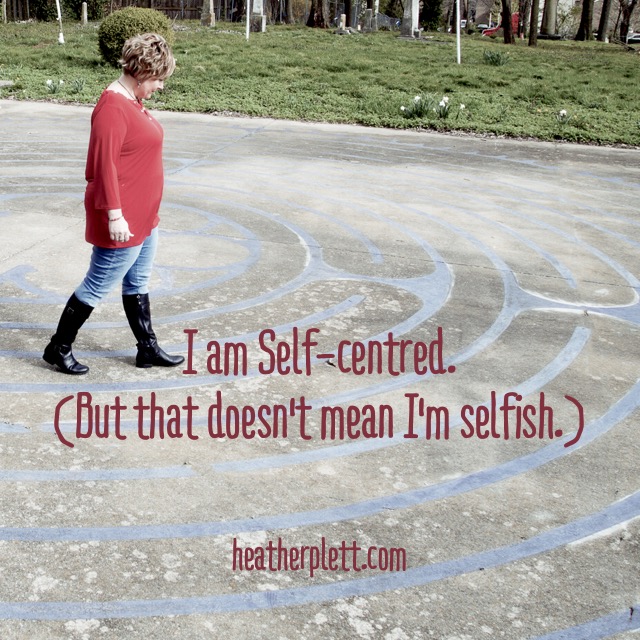
Growing up in a Mennonite home, where self-sacrifice was one of the highest goods, I was convinced that self-centredness was one of the seven deadly sins.
But as I near my fiftieth year on the planet, I’m learning to be Self-centred, and I’m no longer convinced that’s wrong.
This afternoon, after spending many hours gathering all of the tidbits of my business finances together to bring to the accountant for tax preparation (I’m a disorganized business person), I decided to take advantage of the beautiful Spring weather and go to the park. King’s Park, which houses the labyrinth I love, is one of my favourite places to welcome Spring because the two harbingers of Spring on the prairies – crocuses and frogs – can be found there.
Not surprisingly, the old stories came up on the way there. “Your tax bill is going to be high this year – you should be working so you can afford to pay it.” “If you’re not working at your business, you should at least be cleaning the house. Have you looked at the kitchen floor lately? Disgusting.” “If you’re not cleaning or working on your business, shouldn’t you be giving up your free time for a friend who needs you?”
And then the biggie…
“You are being self-centred.”
I smiled at the voices and let them play through their stories in my head, and then I went to the park anyway. I know they mean me no harm – they are there to protect me – and I also know that giving them the upper hand will keep my life small and unhappy. Time in the sunshine is not something I feel guilty about, especially when the taxes are done.
I walked the labyrinth, not in a slow and meditative way, but in a curious and attentive way, watching for the fuzzy heads of crocuses popping up between the paths. The crocuses weren’t quite ready to bloom, but I was rewarded for my attentiveness with a frog who let me get close enough to take a picture.
As I neared the centre of the labyrinth, a new thought popped into my head…
Perhaps it’s a good thing to be Self-centred.
What if, instead of interpreting self-centred as selfish, we interpret it as “keeping your Self at the centre”?
I capitalize Self here, because I’m referring to the spiritual Self, the higher Self, the one that seeks wholeness within a deep relationship with God/dess.
When we walk the labyrinth, we pause at the centre, because that is where we are most in touch with our Self. That is where we rest in openness, ready to receive Spirit. That is where we are most emptied of ego and fear and the false stories that keep us small.
The labyrinth teaches us to be Self-centred.
Paradoxically, a Self-centred life is actually less selfish than an other-centred life, because we don’t rely on others to fulfill us or make us happy. We don’t place unrealistic expectations on others to define us or behave a certain way. We allow others their own happiness without placing obligations on them to make us happy. We give out of our fullness rather than out of our neediness. We are at peace and therefore we create an environment where others can be at peace too.
When we are Self-centred, we do our own work and don’t expect others to fix us.
When we are Self-centred, we detach ourselves from other people’s behaviour and give them the freedom to find their own paths to their own Selves.
When we are Self-centred we find out who we truly are and we no longer rely on other people’s definition of us.
When we are Self-centred, we serve other people out of our delight in them and not out of obligation or need.
When we are Self-centred, we can offer and receive unconditional love.
When we are Self-centred, we can live in community and not expect that community to give us everything we need.
When we are Self-centred, we hold space for our Selves and that allows us to hold space for others without losing ourselves in them.
One month from tomorrow, I’ll turn 50. As I near that milestone, I’m making it my goal to become more Self-centred.
********
If you want to be more Self-centred, a journey through The Spiral Path or Mandala Discovery might help.
Interested in more articles like this? Add your name to my email list and you’ll receive a free ebook, A Path to Connection and my weekly reflections.
by Heather Plett | Dec 11, 2015 | Christmas, Spirituality
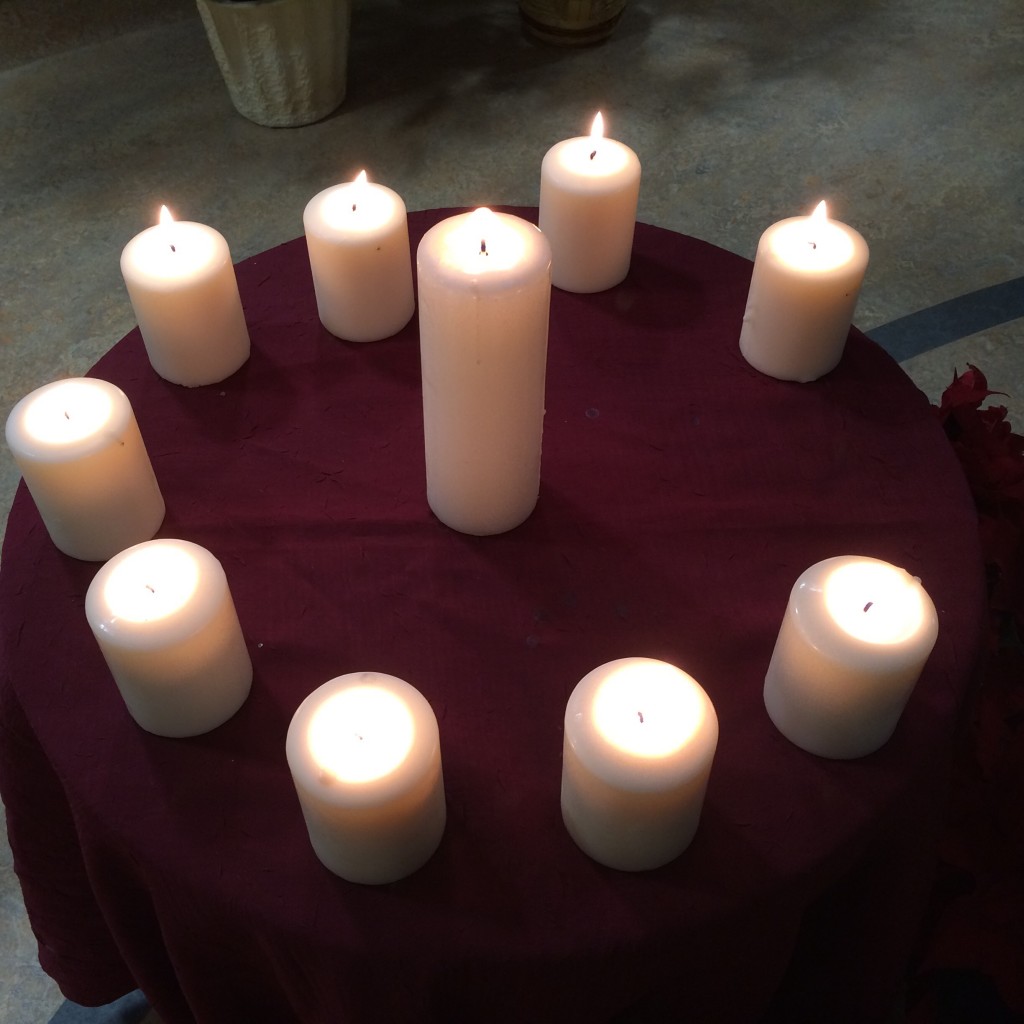
This week, at the invitation of my friend Doug, I attended a celebration of light, held in the sanctuary at a local hospital. It was a simple and beautiful ceremony, where people from several different spiritual traditions were invited to light their candles from the same source candle and then share a short piece about what light means in their tradition.
The Hindu person spoke about Diwali, the festival of lights, the Jewish person spoke about the lighting of the menorah, the Indigenous elder spoke about how they honour Grandfather Sun and Grandmother Moon, and so on. After all of the candles were lit, they passed the light around the room to all of us, each of us lighting another person’s small taper candle. We stood together with our candles lit, singing John Lennon’s Imagine.
Imagine there’s no countries
It isn’t hard to do
Nothing to kill or die for
And no religion too
Imagine all the people
Living life in peace…
The richness of the simple ceremony left me with my own imagining.
Imagine the light
Imagine a circle of peace, each of us with different beliefs bearing light for each other.
Imagine Muslims standing with Christians, Jews standing with Hindus – all of us standing together to bear light for those who would rather spread darkness.
Imagine all light coming from the same Source, with none of us owning it but all of us taking responsibility for passing it on.
Imagine all of us working every day to dispel the darkness for others.
Imagine never protecting our own light, but passing it freely to others, believing that their light does not diminish our own.
In the Northern Hemisphere, we will soon celebrate Winter Solstice, when the earth begins to tilt the other direction again and the light returns. Whether or not you are in this hemisphere, I invite you to consider how you wish to welcome light back into your life during this season.
How do you open yourself to Source to receive the light? How do you choose to live as a light-bearer? How do you pass your light on to others? How do you receive the light that others pass to you?
Your light doesn’t have to light the whole world – it simply has to light the space three feet around you. Pass it on to the next person and see how quickly the room fills with light.
“Darkness cannot drive out darkness: only light can do that. Hate cannot drive out hate: only love can do that.” ― Martin Luther King Jr
by Heather Plett | Jan 17, 2015 | Labyrinth, Spirituality, Uncategorized
 “Release, receive, and return.” That’s what the labyrinth invites us to do.
“Release, receive, and return.” That’s what the labyrinth invites us to do.
Yesterday, I needed to release, receive, and return. I was stressing out about the ongoing tension between “do the thing that brings in money” and “do the thing that’s calling you next” – the ever-present question of all soulful entrepreneurs.
I wanted to go to the labyrinth, but it’s covered in snow, so I did the next best thing… I made a finger labyrinth. It turns out that making a labyrinth is almost as good as walking one for that whole “release, receive, and return thing.”
Since I use labyrinths a lot in my work (especially The Spiral Path, which is a 21 lesson journey through the labyrinth to your authentic heart), I thought I’d share the steps in making my finger labyrinth in case you’d like to make one too.
You’ll need:
- a square canvas or piece of wood (I used an 11X11″ canvas)
- a print out of your favourite labyrinth design, printed to the scale of the canvas (For an 11X11 canvas in the 7 path Chartres design that I made, here’s a pdf that prints on two 8.5X11 pieces of paper. If you prefer a different design, just Google “labyrinth template”)
- heavy string
- glue (I used a hot glue gun and white glue, but if you don’t have a glue gun, white glue is fine)
- newsprint or other paper (whatever you use should be fairly thin)
- mod podge (or just use gel medium)
- gel medium
- acrylic paint
Step 1. Print the labyrinth design and glue it onto the canvas or board. I used ordinary white glue, spread thin with a spreader (any straight plastic edge, like an old credit card) will work. Use the spreader to work out any bubbles in the paper (though it doesn’t have to be too fussy, since you’ll cover it).
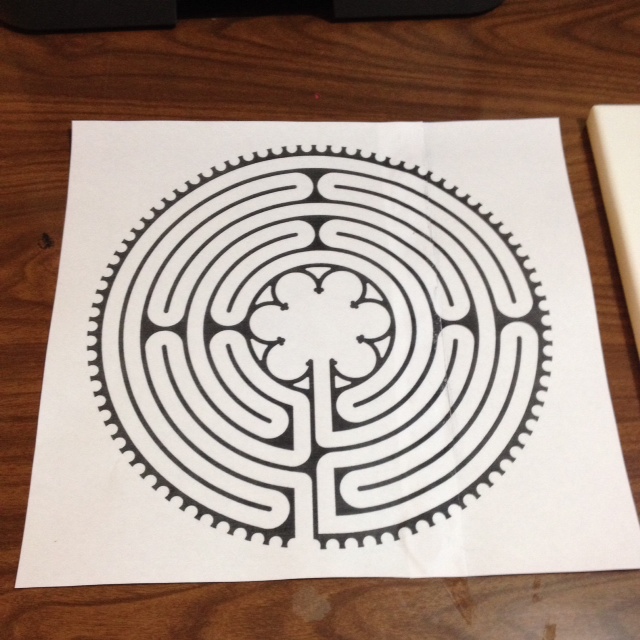
Step #2. Glue heavy string onto all of the black lines. I used the hot glue gun for this because it dries faster, but it would work fine with white glue.
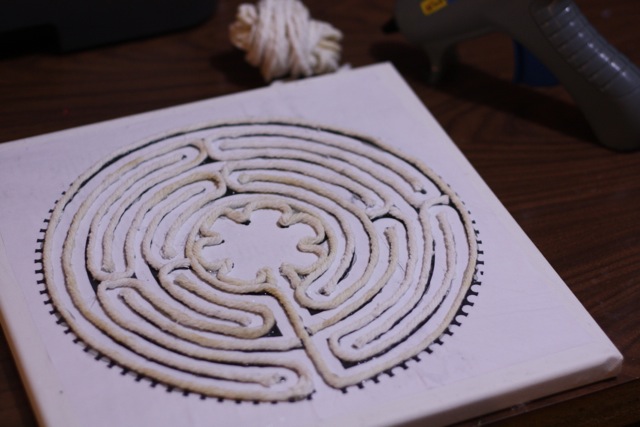
Step #3. Cut lots of short strips of newsprint. I used blank newsprint, because it’s easier to paint over, but you could use newspaper. You could also use coloured paper if you don’t want to paint it. Tissue paper would also work, but you’d need a few layers to make sure the black is covered. The strips I used were approx. .75″ by 3″. You don’t have to be fussy about it, but you’ll want them wide enough to cover the string and adhere to the surface without covering two lines of string at the same time.
Step #4. Slather mod podge (or gel medium) generously on a section of string. Add a strip of paper and cover the paper with more mod podge (or gel medium). The best way to do this is with your fingers, so be prepared to get a little messy.
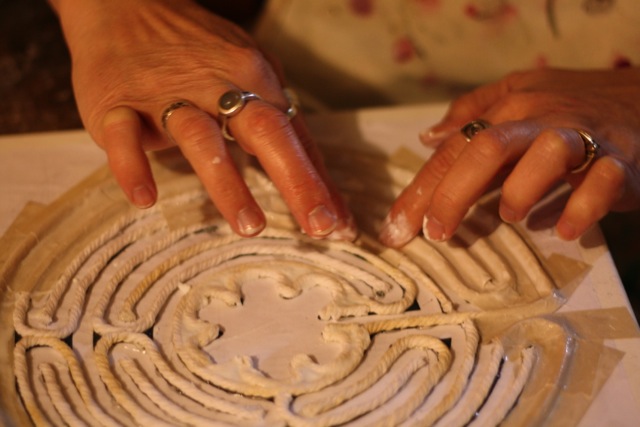
Step #5. Keep going until you have the whole labyrinth and canvas covered with strips of paper. Some spots are tricky (especially if you decide to do the flower pattern at the centre, like I did), so you’ll have to let go of your inner perfectionist and let it be a little imperfect. Make sure it’s all well coated with mod podge (or gel medium). Let it dry.

Step #6. If you want to paint it, add a layer of gel medium once it’s dry (this time you can do it with a paint brush) to smooth out some of the rough edges and to make sure the paint adheres to the surface.
Step #7. Paint it however you like. I used three tones of acrylic paint for the ombre effect (crimson, burnt sienna and ochre.
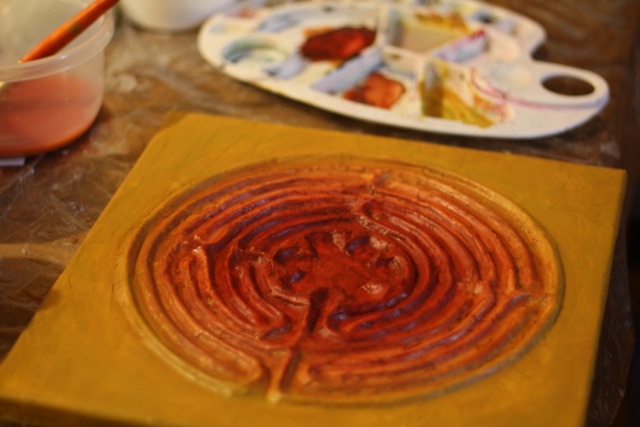
Step #8. If you want to give it a more textured, aged effect, rub a glaze over it. I used a brown glaze (acrylic paint mixed with gel medium) and rubbed it on with your fingers. Because I’d layered on the gel medium a little too thick, there were some cracks and the dark glazed picked these up, giving it a bit more of an aged look.
Step #9. Hang it on your wall or keep it in your studio, bedroom, or sanctuary where you can use it as a meditation tool.
Here are some tips for using your finger labyrinth…
- Before you start, take some time to settle in to a position in which you’re comfortable. Take some slow deep breaths to centre you in your practice.
- You may want to journal before and/or after the practice.
- Before you begin, you may wish to set an intention or ask a question that you will carry with you into the labyrinth, but be careful to keep it open-ended so that you’re open to surprise.
- Say a prayer, if you like, for support, healing, and guidance.
- Place a finger at the entrance of the labyrinth. Some people suggest that you use your non-dominant hand, as research suggests that our non-dominant hand has easier access to our intuition.
- As you follow the path with your finger inward, be conscious and intentional about releasing whatever stresses, worries, or distractions you might be feeling. Breathe deeply and slowly.
- Pause whenever you want, but don’t lift your finger off the labyrinth.
- When distracting thoughts come up, simply let them pass and wish them well as they leave your mind.
- When you reach the centre, pause for awhile and receive. Be open to whatever guidance and wisdom you may need, even if it’s not what you expected.
- When you’re ready, follow the path outward, consciously returning and bringing the wisdom of the centre out into your life with you.
- In your journal, write or sketch anything that came to you while you made the journey.
- Don’t try too hard. Sometimes the wisdom of the labyrinth is simply the pause that it forces you to take. Sometimes nothing obvious shows up, but that doesn’t mean it wasn’t time well spent. Stay open and receptive.
Starting February 1, 2015, you can join me in a 21 lesson journey through the labyrinth, back to your authentic heart in The Spiral Path: A Woman’s Journey to Herself. In the first seven lessons, you’ll release what no longer serves you. In the next seven lessons, you’ll open yourself to receiving. In the final seven lessons, you’ll return from the journey.
by Heather Plett | Oct 14, 2014 | journey, Labyrinth, mandala, painting, Passion, Spirituality, Uncategorized
I often use labyrinths in my retreats and workshops, and until now I’ve either used what’s available onsite, or I’ve created them with string, mowed them into grass, or made them out of dried leaves.
This weekend, I finally made a portable labyrinth that I can carry with me.
 When I shared the result on social media, several people asked for details about how I made it. Here’s how:
When I shared the result on social media, several people asked for details about how I made it. Here’s how:
 1. Since canvas can be quite expensive, I looked for a less expensive alternative. At the local Home Depot, I found painting drop cloths that were 4′ x 20′. They worked well because they’re fabric on one side and plastic on the other so that they absorb the paint without soaking through to the floor. Plus they’re fairly light weight for easier transport. (They cost $22 each, so my total investment was $110, since I had all of the other materials on hand.)
1. Since canvas can be quite expensive, I looked for a less expensive alternative. At the local Home Depot, I found painting drop cloths that were 4′ x 20′. They worked well because they’re fabric on one side and plastic on the other so that they absorb the paint without soaking through to the floor. Plus they’re fairly light weight for easier transport. (They cost $22 each, so my total investment was $110, since I had all of the other materials on hand.)
2. I wanted to make my labyrinth approximately 20′ x 20′, so I bought 5 drop cloths and sewed them together. They’re hemmed along the long edges, and at first I was going to seam-rip all of the hems, but that was far too tedious, so I just cut off the hems (losing a bit of the width, but I was okay with that) and sewed them. Tip: I had access to a large space for my labyrinth creation (a church floor), and I recommend doing the sewing in a fairly large space too. It’s bulky and a little awkward.
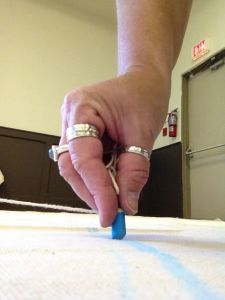 3. Once the dropcloths were sewn together, I drew the outline of the labyrinth with chalk. I started by measuring where my centre was and making a chalk mark there. Then I placed a paint can at the centre and tied a long string loosely on it to use as a giant compass/protractor. Tip: Make sure the string is loose enough on the can so that it rotates as you move around the circle.
3. Once the dropcloths were sewn together, I drew the outline of the labyrinth with chalk. I started by measuring where my centre was and making a chalk mark there. Then I placed a paint can at the centre and tied a long string loosely on it to use as a giant compass/protractor. Tip: Make sure the string is loose enough on the can so that it rotates as you move around the circle.
4. I wanted to make a 5-path version of the Chartres labyrinth. To figure out how wide my paths should be, I started by making the largest circle (to within a couple of inches of the edge of the canvas) and then making the centre circle (large enough that three people can comfortably stand in it). Then I measured the distance between the centre circle and the outside circle and divided it by 5. It came to 17.5 inches.
5. Shortening my string each time, I drew the concentric circles. 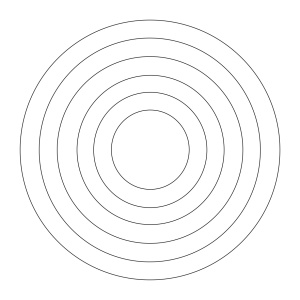
6. From there, it’s a matter of drawing the horizontal and vertical lines and then erasing the parts of the circle that aren’t needed. As you’ll see in the design I used, the horizontal and vertical lines all connect circles, so you need to pay attention to which of the circles you’re connecting, and then measure the same width as your path (17.5″ in my case) from that line to know how much of the circle to erase. Tip: The chalk marks are easy to brush away with a household brush (I used a pot scrubber).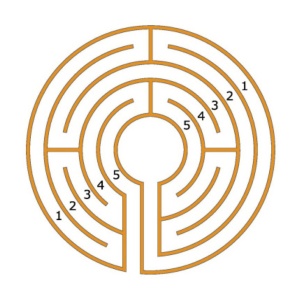
7. Once I had the chalk lines in place, I started painting. To keep it inexpensive, I used some leftover acrylic house paint for my lines, which worked great. I painted on the inside of each chalk line to keep it consistent.
8. For the width of the lines, I simply painted as wide as a small sponge brush. The edges of my lines are not very precise, since it’s hard to attain precision on fabric without driving yourself crazy, but I decided I was fine with that. It might have worked to put painters tape down, but that seemed like a lot of extra work to me (and I only had the space for a limited time) and I wasn’t sure how the tape would work around circles.
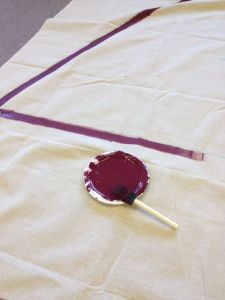 9. After the paint had dried, I decided to touch up the edges a bit with a thinner brush. It took a fair bit of extra time, but I liked the more solid line, so it was worth it.
9. After the paint had dried, I decided to touch up the edges a bit with a thinner brush. It took a fair bit of extra time, but I liked the more solid line, so it was worth it.
10. I let it dry for about 12 hours before folding it. It might have been a good idea to leave it longer, but the space was being used the next day so I needed to move it.
The hardest part of the whole process was all of the time spent (about 8 hours) crouching on the floor. By the end of it, I had a hard time unfolding my body! Stretching during my breaks helped, but I could have been more diligent.
by Heather Plett | Oct 3, 2014 | Beauty, growth, journey, Spirituality, Uncategorized, Wisdom
 I was raised on a healthy dose of “only a sinner, saved by grace”. Again and again the Sunday School songs reminded me to carry the shame of the sin that had separated me from God. I was nothing without salvation – a wretch, a lost soul, a disgrace.
I was raised on a healthy dose of “only a sinner, saved by grace”. Again and again the Sunday School songs reminded me to carry the shame of the sin that had separated me from God. I was nothing without salvation – a wretch, a lost soul, a disgrace.
On top of that, I was a woman – reduced to second class in the eyes of a male (understanding of) God. Not good enough to have my own voice. Not strong enough to lead without a man as the head.
And then, to add to those stories of unworthiness and submissiveness, I was a Mennonite, taught to be a pacifist, discouraged from standing up for myself. Turn the other cheek and don’t rock the boat.
Let’s not forget that I’m also a Canadian, and people in my country place politeness high in our values.
That’s a lot of old stories that contribute to my “I am worthless” back story.
Now…I’m not going to argue the theology or “rightness” of any of those belief systems – I’m just speaking from my own experience here. I’m just saying that it’s hard to emerge from a history like that with a healthy self-confidence and a belief in one’s worthiness.
It took a lot of personal work to start telling myself other stories. It took a lot to begin to believe that I was worthy of love, that I was equal to men, that I could believe in a God that was both masculine AND feminine, and that I was “fearfully and wonderfully made”.
For awhile the pendulum swung in the other direction. I started to embrace those self-help books that told me that I am awesome, I am powerful, and I can do anything I set my mind to. I started to believe that I was a self-made woman and that I didn’t need faith in a God who made me feel worthless.
But the other end of the pendulum wasn’t comfortable for long either. If I am awesome, than I don’t need other people. If I am perfect the way I am than I can get away with treating people poorly and not cleaning up after myself. If I can do anything I set my mind to, then I don’t need grace and I don’t need God and I certainly don’t need to pay attention to the wounds all of us AWESOME people are inflicting on the world.
And what if I don’t FEEL awesome all of the time? Then do I send myself back to the “unworthy” end of the pendulum because other people have figured out this self-help stuff better than I have? And what about when I do something that is really selfish – do I simply excuse myself with an “I am worth it” mantra? Do I never hold myself accountable for my screw-ups or unkind acts? And if there’s no need for grace, then how do I pick myself up after a particularly horrible failure?
Gradually the pendulum swung back, but this time it landed somewhere in the middle. This time it stopped in the grey area – the paradox.
- I am beautiful AND I have a lot of flaws.
- I am smart and capable and have a lot of gifts AND I need to be forgiven when I make mistakes.
- I am loving and kind AND sometimes I do things that are downright mean and hurtful.
- I have been fearfully and wonderfully made AND I need a lot of grace for those times when I don’t act or feel like it.
- I am full of wisdom AND I rely on God/dess to help me use that wisdom with discernment.
- I am a sinner AND I am a saint.
- I am good enough as I am AND I need to keep working to improve myself.
- I am as worthy as any man on earth AND I want to keep living on a planet where both genders are needed.
The grey area is a good place to live. It feels comfortable, because I don’t need to be perfect, but I also don’t need to believe that I am worthless. It’s the field that Rumi talks about – I want to lie down in that grass with you.
“Beyond our ideas of right-doing and wrong-doing,
there is a field. I’ll meet you there.
When the soul lies down in that grass,
the world is too full to talk about.
Ideas, language, even the phrase ‘each other’
doesn’t make sense any more.”
Rumi
p.s. There is still space in tomorrow’s Openhearted Writing Circle, if you want to explore how your own writing can help you get to an “I am enough” place.
by Heather Plett | Aug 21, 2013 | Community, Spirituality, Uncategorized
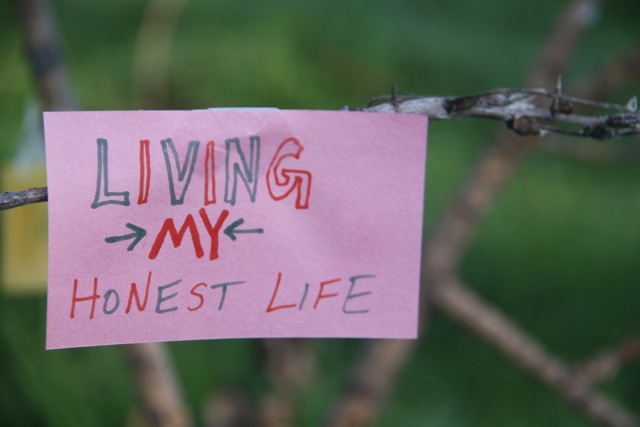
I am spiritual. That’s no surprise to you if you’ve been reading this blog for any period of time.
But it might be a surprise to you that I haven’t always been comfortable being “out” about my spirituality.
For starters, I was raised in a fairly conservative evangelical Mennonite family where faith was fairly black and white and you didn’t walk labyrinths, make prayer flags, take Buddhist meditation classes, pray to the Divine Feminine, embrace other faith perspectives, or talk about the way God speaks through a deer or a tree.
When I started exploring those things, I was afraid of rejection, and so I kept most of my exploration secret. There was a little too much fear of going to hell if you “worshipped false gods” in those circles, and that fear lingered deep in my own psyche long after I thought I’d dealt with it. I still don’t talk about it very much in some circles, and to be honest, I’m still excavating some of my rejection and fear stories around that. (I still consider myself a Christ-follower, by the way, but my understanding of what that means has shifted dramatically.)
For another thing, I spent a lot of years in the corporate world where any talk of spirituality was strictly taboo. Though I sometimes thought that my staff or the management teams I was on might be better off if we brought mindfulness and more spiritual openness into what we did, I wasn’t confident enough in my own exploration yet to introduce it. Again, it was mostly fear of rejection that kept me silent.
When I quit my job and started my own business, I started out as a split personality, still trying to keep my spirituality mostly in the closet. I had two websites – one was the polished, corporate-looking one I showed potential clients and students in my university classes, and the other was the blog where I explored the things that mattered most to me, including spirituality. Every time someone from the corporate/university world found the blog, I cringed a little, worried that they would no longer take me seriously as a consultant or teacher. There is, after all, an assumption in our culture that being spiritual means that you’re less intellectual and probably a little weaker than others.
About a year and a half ago, I started to realize that maintaining these two public faces was creating angst for me and making me feel disingenuous. After a couple of failed consulting gigs, I realized that I really didn’t want to work with clients who wouldn’t be comfortable with my spirituality. After trying to be something in the classroom I really wasn’t, I realized that my best teaching happened when I was authentically me.
And so I came out. I combined my blog with my website, integrated my spirituality into my consulting/facilitation/teaching work, and got used to stepping into a classroom where students and administration might think me a little “flakey or too woo-woo”.
I can’t tell you that it magically brought me all of the “right” kinds of clients (it’s still a gradual process), but I can tell you that things started to shift. In the very first class I taught after deciding to be more open and sharing my blog with students, I had four students approach me individually, interested in coming to me for coaching because they were looking for something deeper than they could receive in a classroom. And I started to get invitations to do amazing work that fits me perfectly, like the week long artists’ retreat I facilitated last week in Saskatchewan.
Yes, my work has shifted, and I’m sure a few corporate clients have been turned away by language that feels uncomfortable for them, but that’s okay.
More and more, my work is a true expression of who I am, not just the skills I can offer. More and more, I am bringing the full basket of my gifts and wisdom into what I offer.
And the right people are showing up. Almost all of my coaching clients, for example, share stories of how they too are trying to live more authentically and more boldly in a world that expects them to be more “corporate, straight, conventional, unemotional, etc.” They show up with their own fear of rejection stories and I can truly say “I see you.” And in the last six months, I’ve had the opportunity to host half a dozen retreat/workshops that are all about connecting on a deeper, more spiritual way. Again, I am more prepared to host them because I have been on my own journey to this deeper, more authentic place.
Another interesting thing has happened. Some of the people whose rejection I feared are coming forward and saying “Your work resonates with me. I’m curious about labyrinths/mandalas/etc. Can you tell me more?” My own “coming out” is encouraging others to be more honest about their own questions and exploration.
What about you? Do you sometimes feel like a fraud because you’re hiding the titles of the books you read from your colleagues at work? Do you take meditation classes in secret because you don’t want your family to know? Do you furtively read blog posts that make your heart sing, but you’re quite sure nobody in your world would understand? Do you feel like one of my clients, who said she is “kind of a weirdo, but in a good way”? Have you despaired of finding a circle of people like you who have questions that most people think are too “out there”?
You will need to find your own path through this, but you don’t have to do it alone. There are more of us spiritual seekers out here in this big world than you might imagine. Trust me – when I started being more open about my quest, I started connecting with a lot of amazing people who, like me, want to dive into meaningful conversations that go far beyond small talk, straight to the heart.
Here are a few thoughts on how you can begin to move into a more integrated, authentic life:
- Start small. Find at least one person who feels like a safe space to talk about your quest. This might be someone you already know and trust, someone at a yoga class, or a coach like me. Before you start the conversation, though, be sure that the person you’re talking to can respond in a non-judgemental way. If you face judgement in your very first conversation, your authentic you will run further into hiding.
- Find a place where you can be true to yourself. This might be your journal, a secret place in the woods, your favourite coffee shop or bookstore, or your art studio. In that space, commit to being totally honest with yourself about who you are and what you seek in the world. Read the books you want to read, write the truth that longs to be said, and dare to stand in awe of an eagle that seems to have a message just for you.
- Find a practice that connects you with your spiritual Self. There are many options – yoga, dance, meditation, walking, running, painting, mandala-making, etc. Do something that brings you peace and leaves you feeling connected to that authentic part of you that’s been buried under other people’s expectations.
- Practice truthfulness one tiny step at a time. If you are feeling inauthentic at work, find a least one co-worker whom you trust who won’t laugh at you when you admit to going on a meditation retreat. If that feels safe, take another step. You may be surprised to find other secret questers longing for the same conversation.
- Consider your priorities. If your steps to being more authentic at work feel unsafe or leave you feeling judged, consider how important it is to stay there. Is it time to walk away? Are you living a lie if you stay there?
- Recognize that some people will never “get it” and that’s okay. Some people might suggest that you should walk away from anyone who rejects your version of a spiritual quest, but life is far more complex than that. If a family member, for example, doesn’t understand it, then find other topics to talk about in their presence. You don’t need to lie to them, but you also don’t need to reveal your deepest heart to everyone in your life.
- Find community where you feel safe. With the internet making long distance relationships more and more accessible, it has become easier and easier to find circles where you can talk about your questions and spiritual quest. I wouldn’t say that virtual circles replace in-person relationships, but it’s at least a place to start. For example, many of the people who sign up for Lead with Your Wild Heart say that one of the best things about the program is the fact that they no longer feel alone in their quest for authenticity.
- Read a book or two that helps you understand your own quest. A few recommendations: Falling Upward: A Spirituality for the Two Halves of Life, A Hidden Wholeness: The Journey Toward an Undivided Life, The Seeker’s Guide: Making your Life a Spiritual Adventure, and What We Talk About When We Talk About God.
In all that you do, remember this – this journey is a long one. You don’t get to authentic overnight. It took me many years to realize some of the places I was living a divided life, and I know that there are still more realizations to come.
Take the journey one step at a time, and find companions along the way.

















